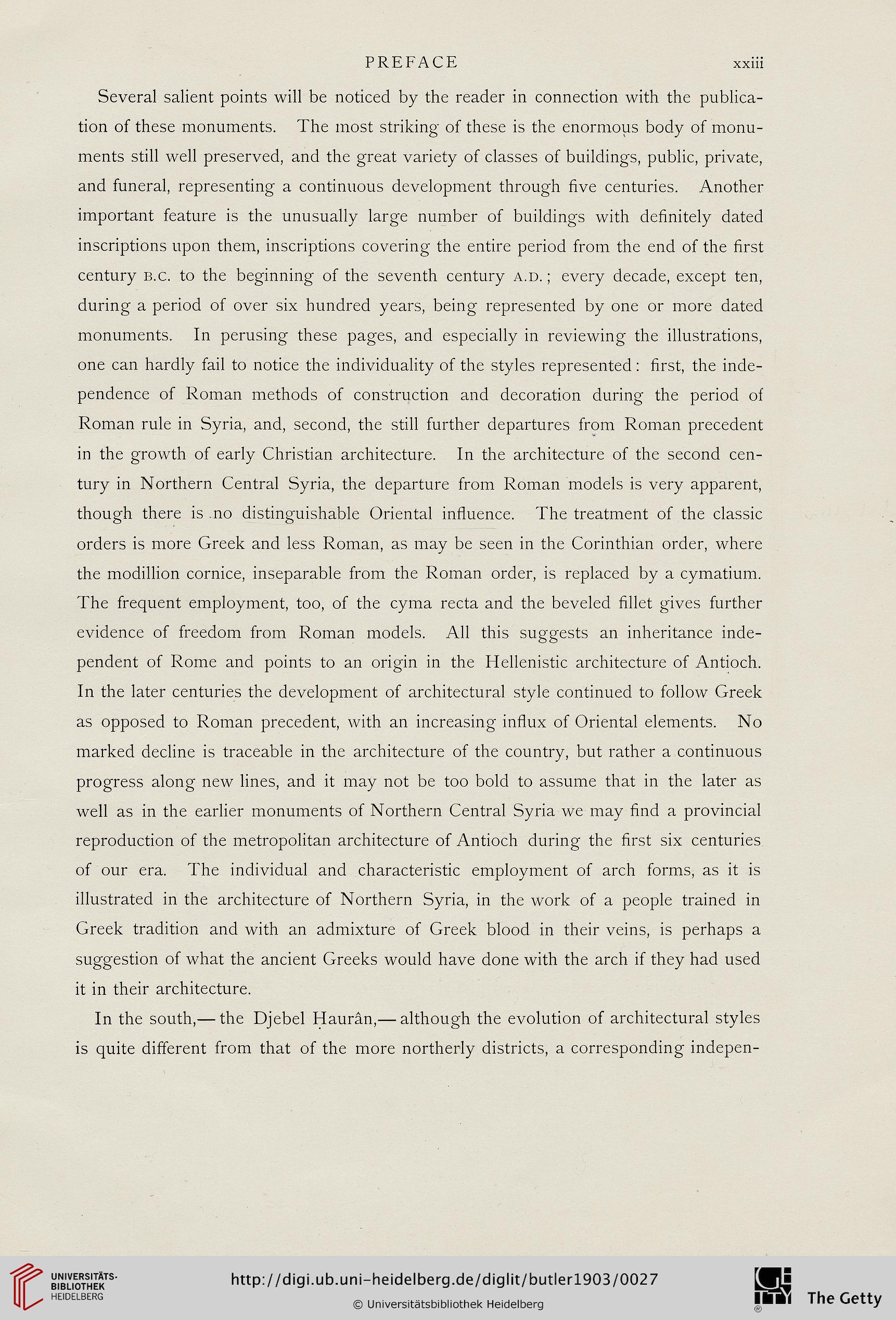PREFACE xxiii
Several salient points will be noticed by the reader in connection with the publica-
tion of these monuments. The most striking of these is the enormous body of monu-
ments still well preserved, and the great variety of classes of buildings, public, private,
and funeral, representing a continuous development through five centuries. Another
important feature is the unusually large number of buildings with definitely dated
inscriptions upon them, inscriptions covering the entire period frotn the end of the first
century b.c. to the beginning of the seventh century a.d. ; every decade, except ten,
during a period of over six hundred years, being represented by one or more dated
monuments. In perusing these pages, and especially in reviewing the illustrations,
one can hardly fail to notice the individuality of the styles represented: first, the inde-
pendence of Roman methods of construction and decoration during the period of
Roman rule in Syria, and, second, the still further departures from Roman precedent
in the growth of early Christian architecture. In the architecture of the second cen-
tury in Northern Central Syria, the departure from Roman models is very apparent,
though there is no distinguishable Oriental influence. The treatment of the classic
orders is more Greek and less Roman, as may be seen in the Corinthian order, where
the modillion cornice, inseparable from the Roman order, is replaced by a cymatium.
The frequent employment, too, of the cyma recta and the beveled fillet gives further
evidence of freedom from Roman models. All this suggests an inheritance inde-
pendent of Rome and points to an origin in the Hellenistic architecture of Antioch.
In the later centuries the development of architectural style continued to follow Greek
as opposed to Roman precedent, with an increasing influx of Oriental elements. No
marked decline is traceable in the architecture of the country, but rather a continuous
progress along new lines, and it may not be too bold to assume that in the later as
well as in the earlier monuments of Northern Central Syria we may find a provincial
reproduction of the metropolitan architecture of Antioch during the first six centuries
of our era. The individual and characteristic employment of arch forms, as it is
illustrated in the architecture of Northern Syria, in the work of a people trained in
Greek tradition and with an admixture of Greek blood in their veins, is perhaps a
suggestion of what the ancient Greeks would have done with the arch if they had used
it in their architecture.
In the south,— the Djebel Hauran,— although the evolution of architectural styles
is quite different from that of the more northerly districts, a corresponding indepen-
Several salient points will be noticed by the reader in connection with the publica-
tion of these monuments. The most striking of these is the enormous body of monu-
ments still well preserved, and the great variety of classes of buildings, public, private,
and funeral, representing a continuous development through five centuries. Another
important feature is the unusually large number of buildings with definitely dated
inscriptions upon them, inscriptions covering the entire period frotn the end of the first
century b.c. to the beginning of the seventh century a.d. ; every decade, except ten,
during a period of over six hundred years, being represented by one or more dated
monuments. In perusing these pages, and especially in reviewing the illustrations,
one can hardly fail to notice the individuality of the styles represented: first, the inde-
pendence of Roman methods of construction and decoration during the period of
Roman rule in Syria, and, second, the still further departures from Roman precedent
in the growth of early Christian architecture. In the architecture of the second cen-
tury in Northern Central Syria, the departure from Roman models is very apparent,
though there is no distinguishable Oriental influence. The treatment of the classic
orders is more Greek and less Roman, as may be seen in the Corinthian order, where
the modillion cornice, inseparable from the Roman order, is replaced by a cymatium.
The frequent employment, too, of the cyma recta and the beveled fillet gives further
evidence of freedom from Roman models. All this suggests an inheritance inde-
pendent of Rome and points to an origin in the Hellenistic architecture of Antioch.
In the later centuries the development of architectural style continued to follow Greek
as opposed to Roman precedent, with an increasing influx of Oriental elements. No
marked decline is traceable in the architecture of the country, but rather a continuous
progress along new lines, and it may not be too bold to assume that in the later as
well as in the earlier monuments of Northern Central Syria we may find a provincial
reproduction of the metropolitan architecture of Antioch during the first six centuries
of our era. The individual and characteristic employment of arch forms, as it is
illustrated in the architecture of Northern Syria, in the work of a people trained in
Greek tradition and with an admixture of Greek blood in their veins, is perhaps a
suggestion of what the ancient Greeks would have done with the arch if they had used
it in their architecture.
In the south,— the Djebel Hauran,— although the evolution of architectural styles
is quite different from that of the more northerly districts, a corresponding indepen-




